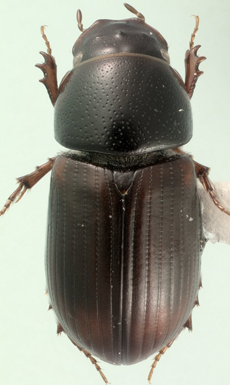 |
|||||||
|
|||||||
Planolinoides Dellacasa and Dellacasa 2005
Planolinoides Dellacasa and Dellacasa 2005: 77.
Photo by P. Skelley.
|
||
|
||
| Aphodiinae Overview | ||
| Aphodiini Key |
Type species. Aphodius borealis Gyllenhal 1827: 48, by original designation.
Diagnosis. Body length 3.2-6.0 mm, elongate, robust, dark brown to black; dorsal surface usually dulled, apical declivity of elytra always opaque; body lacking setal fringe. Clypeal surface with transverse ridge. Pronotal base with distinct marginal line. Metatibial apical spinules short, equal in length. Male genitalia with parameres short, about 1/4 as long as basal capsule, heavily sclerotized.
Distribution. Palearctic, North America.
Composition. Planolinoides contains 5 species.
Planolinoides aenictus (Cooper and Gordon 1987: 532) [Aphodius], SE-Canada to PA-USA.
Planolinoides borealis (Gyllenhal 1827: 48) [Aphodius], Canada, AK-USA, Europe?
= Aphodius errans Brown 1930: 243.
= Aphodius evanescens Bouskell 1901: 23.
= Aphodius gyllenhalii Seidlitz 1891: 143.
= Aphodius hespericus Gistel 1857: 589.
= Aphodius sedulus Harold 1871: 119.
Planolinoides duplex (LeConte 1878: 454) [Aphodius], Canada, USA, Mexico.
Planolinoides neotomae (Fall 1907: 243) [Aphodius], OR,CA-USA, Mexico.
Planolinoides pectoralis (LeConte 1857: 41) [Aphodius], SW-Canada, W-USA.
Life History. Members of Planolinoides appear to be surface dung generalists. Planolinoides neotomae specializes on pack rat dung.
Larvae. The larvae of P. neotomae and P. pectoralis are described in Ritcher (1966), and P. borealis by Frolov and Ivanov (2001).
References:
Dellacasa, M. and G. Dellacasa. 2005. Comments on some systematic and nomenclatural questions in Aphodiinae with descriptions of two new genera and on Italian taxa (Coleoptera: Aphodiidae). Memorie della Societa Entomologica Italiana 84: 45-101.
Frolov, A. V., and A. V. Ivanov. 2001. On the larval morphology of Aphodius borealis Gyllenhal and A. corvinus Erichson (Coleoptera: Scarabaeidae). Annales Zoologici (Warsaw) 51(3): 347-349.
Gordon, R. D., and P. E. Skelley. 2007. A monograph of the Aphodiini inhabiting the United States and Canada (Coleoptera: Scarabaeidae: Aphodiinae). Memoirs of the American Entomological Institute 79: 580 pp.
Ritcher, P.O. 1966. White grubs and their allies: A study of North American scarabaeoid larvae. Oregon State University Press, Corvallis, Oregon. Studies in Entomology 4: 219 pp.
|
||||
| Author: Paul Skelley Generated on: 01/MAY/08.....Last modified: 01/MAY/08 University of Nebraska State Museum - Division of Entomology |
